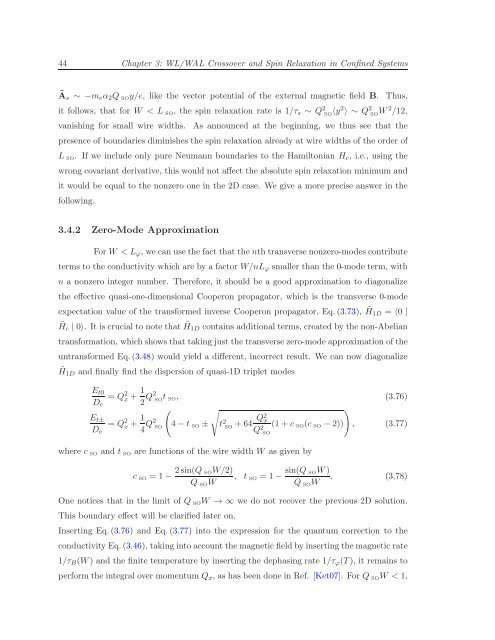Itinerant Spin Dynamics in Structures of ... - Jacobs University
Itinerant Spin Dynamics in Structures of ... - Jacobs University
Itinerant Spin Dynamics in Structures of ... - Jacobs University
Create successful ePaper yourself
Turn your PDF publications into a flip-book with our unique Google optimized e-Paper software.
44 Chapter 3: WL/WAL Crossover and <strong>Sp<strong>in</strong></strong> Relaxation <strong>in</strong> Conf<strong>in</strong>ed Systems<br />
à s ∼ −m e α 2 Q SO y/e, like the vector potential <strong>of</strong> the external magnetic field B. Thus,<br />
it follows, that for W < L SO , the sp<strong>in</strong> relaxation rate is 1/τ s ∼ Q 2 SO〈y 2 〉 ∼ Q 2 SOW 2 /12,<br />
vanish<strong>in</strong>g for small wire widths. As announced at the beg<strong>in</strong>n<strong>in</strong>g, we thus see that the<br />
presence <strong>of</strong> boundaries dim<strong>in</strong>ishes the sp<strong>in</strong> relaxation already at wire widths <strong>of</strong> the order <strong>of</strong><br />
L SO . If we <strong>in</strong>clude only pure Neumann boundaries to the Hamiltonian H c , i.e., us<strong>in</strong>g the<br />
wrong covariant derivative, this would not affect the absolute sp<strong>in</strong> relaxation m<strong>in</strong>imum and<br />
it would be equal to the nonzero one <strong>in</strong> the 2D case. We give a more precise answer <strong>in</strong> the<br />
follow<strong>in</strong>g.<br />
3.4.2 Zero-Mode Approximation<br />
For W < L ϕ , we can usethe fact that thenthtransversenonzero-modes contribute<br />
terms to the conductivity which are by a factor W/nL ϕ smaller than the 0-mode term, with<br />
n a nonzero <strong>in</strong>teger number. Therefore, it should be a good approximation to diagonalize<br />
the effective quasi-one-dimensional Cooperon propagator, which is the transverse 0-mode<br />
expectation value <strong>of</strong> the transformed <strong>in</strong>verse Cooperon propagator, Eq.(3.73), ˜H1D = 〈0 |<br />
˜H c | 0〉. It is crucial to note that ˜H 1D conta<strong>in</strong>s additional terms, created by the non-Abelian<br />
transformation, whichshowsthat tak<strong>in</strong>gjustthetransversezero-modeapproximation <strong>of</strong> the<br />
untransformed Eq.(3.48) would yield a different, <strong>in</strong>correct result. We can now diagonalize<br />
˜H 1D and f<strong>in</strong>ally f<strong>in</strong>d the dispersion <strong>of</strong> quasi-1D triplet modes<br />
E t0<br />
= Q 2 x + 1 D e 2 Q2 SOt SO , (3.76)<br />
( √<br />
)<br />
E t±<br />
= Q 2 x<br />
D + 1 e 4 Q2 SO<br />
4−t SO ± t 2 +64 Q2 x<br />
SO<br />
Q 2 (1+c SO (c SO −2)) , (3.77)<br />
SO<br />
where c SO and t SO are functions <strong>of</strong> the wire width W as given by<br />
c SO = 1− 2s<strong>in</strong>(Q SOW/2)<br />
, t SO = 1− s<strong>in</strong>(Q SOW)<br />
Q SO W Q SO W . (3.78)<br />
One notices that <strong>in</strong> the limit <strong>of</strong> Q SO W → ∞ we do not recover the previous 2D solution.<br />
This boundary effect will be clarified later on.<br />
Insert<strong>in</strong>g Eq.(3.76) and Eq.(3.77) <strong>in</strong>to the expression for the quantum correction to the<br />
conductivity Eq.(3.46), tak<strong>in</strong>g<strong>in</strong>toaccount themagneticfieldby<strong>in</strong>sert<strong>in</strong>gthemagneticrate<br />
1/τ B (W) and the f<strong>in</strong>ite temperature by <strong>in</strong>sert<strong>in</strong>g the dephas<strong>in</strong>g rate 1/τ ϕ (T), it rema<strong>in</strong>s to<br />
perform the <strong>in</strong>tegral over momentum Q x , as has been done <strong>in</strong> Ref. [Ket07]. For Q SO W < 1,
















